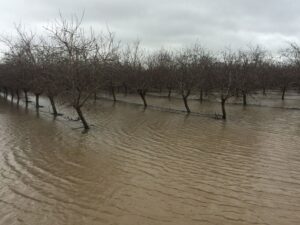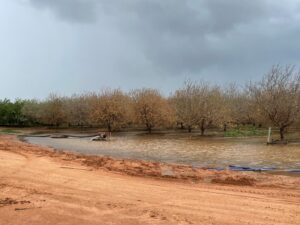
When periods of high amounts of rain occur, orchards can become saturated and flooded. During these periods, tree loss may occur, but this is dependent on the duration of soil saturation, the timing of year, and rootstock.
Soil saturation reduces the ability for oxygen to infiltrate into the rootzone. Roots require oxygen to respire, and long periods of saturation can lead to root loss by asphyxiation. Fine feeder roots are often the first affected, with larger secondary roots affected during periods of extended saturation or flooding. Tree survival is dependent on how many roots survive and can regrow before periods of high transpiration occur.
The sensitivity of almond roots to saturation is dependent on the timing and duration of the flood event. During dormancy, trees are reasonably tolerant due to lower soil temperatures and low rates of respiration. Flood events that are shorter than 7 days will not have any affect on tree performance. Extending beyond this, however, some root loss will occur, and poor spring tree growth may occur. With extended periods – beyond 10 days – tree loss may occur.
After the trees have leafed out, the period of tolerance is much shorter. Standing water within an orchard for 5 days will kill mature trees. This is due to the higher activity of the root system due to warmer soil temperatures, and overall tree activity. In these cases, efforts to drain as much water as possible should occur to reduce the impact of the flooding event.

If water is moving through an almond orchard, the effect of soil saturation/flooding is reduced. Since moving water carries oxygen, some movement of oxygen into the soil can occur. This will extend the period before negative impacts are seen by several days. For example, an orchard near the Merced River was flooded in April, 2016 for several weeks. Trees were alive during the period of 7 days of moving water, but areas of standing water declined and died within the same period.
Some rootstocks are more resistant to soil saturation and flood events. Plum- or plum-hybrid rootstocks tend to tolerate soil saturation for a greater period than peach or peach-almond hybrid rootstocks. The cause of this is unknown, but it is most likely due to the shallower, more laterally formed roots that are common with these rootstocks. This allows more oxygen to move into a larger area/volume of roots.
Post flooding, there are also problems. High water tables or poorly drained areas can continue to kill trees. Phytophthora, a water borne disease, can affect roots that have been saturated as these roots are weaker. Additionally, if the orchard is under water, Phytophthora can affect the aerial parts of the tree, often leading to a quick death once temperatures increase. To manage these root and trunk disease, a foliar spray of potassium phosphite should be considered after leaf-out to improve the tree’s resistance to infection. Please note that there are several ongoing import/export concerns with this potassium phosphite, so consultation with local regulations prior to use is required.
Please note that any suggestion of pesticide use is not a recommendation, and local regulations must always be followed when using any pesticide. Please consort with your local authorities before using any pesticide.


Dhamani
January 17, 2023Hello, thank you for this insightful post. I was wondering if you think due to all the flooding and cold this winter, would it either push almond bloom to happen later, or start earlier? I am trying to understand if all the chill hours the trees have had, would make them break dormancy earlier in the season (maybe beginning of February, rather then mid-Fed). Thank you.
Davidd
February 12, 2023I dont think the flooded fields will impact the timing of flowering too much. Remember, it isnt about the number of chill hours, but rather the amount of heat units that are received that will determine flowering. If it is colder during January and February, the bloom will be delayed. If warmer, it will be accelerated.
Ryan
March 28, 2023What are your thoughts on Lake Tulare’s re-emergence and thousands of acres of farm land being covered in water
Davidd
April 29, 2023Im unsure of what type of an answer you are expecting. I dont see how this can be viewed as anything but a disaster for the people who are affected.
David